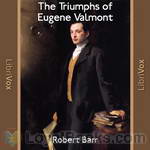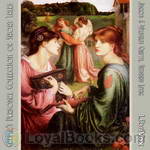|
Books Should Be Free Loyal Books Free Public Domain Audiobooks & eBook Downloads |
|
|
Books Should Be Free Loyal Books Free Public Domain Audiobooks & eBook Downloads |
|
Fiction |
|---|
|
Book type:
Sort by:
View by:
|
By: George B. Grinnell | |
|---|---|
 Blackfeet Indian Stories
Blackfeet Indian Stories
The Blackfeet were hunters, travelling from place to place on foot. They used implements of stone, wood, or bone, wore clothing made of skins, and lived in tents covered by hides. Dogs, their only tame animals, were used as beasts of burden to carry small packs and drag light loads. The stories here told come down to us from very ancient times. Grandfathers have told them to their grandchildren, and these again to their grandchildren, and so from mouth to mouth, through many generations, they have reached our time. (Sibella Denton) | |
By: Giacomo Casanova (1725-1798) | |
|---|---|
 The Memoirs of Jacques Casanova
The Memoirs of Jacques Casanova
This is the first of five volumes. – Giacomo Casanova (1725 in Venice – 1798 in Dux, Bohemia, now Duchcov, Czech Republic) was a famous Venetian adventurer, writer, and womanizer. He used charm, guile, threats, intimidation, and aggression, when necessary, to conquer women, sometimes leaving behind children or debt. In his autobiography Histoire de ma vie (Story of My Life), regarded as one of the most authentic sources of the customs and norms of European social life during the 18th century, he mentions 122 women with whom he had sex... | |
By: Elliott O’Donnell (1872—1965) | |
|---|---|
 Animal Ghosts
Animal Ghosts
Summary: This is a collection of ghost stories in which the antagonists are various animals. Divided up into chapters of ghost sightings by each group of animals, you will hear of hauntings by dogs, cats, birds, jungle animals, etc. (Summary by Allyson Hester) | |
By: Robert Barr (1850-1912) | |
|---|---|
 The Triumphs of Eugene Valmont
The Triumphs of Eugene Valmont
Short stories by a colleague of Jerome K. Jerome, and friend of Sir Arthur Conan Doyle. Barr probably wrote the first parody of Sherlock Holmes (included in this collection). He co-edited “The Idler” with Jerome. [written by Czechchris] | |
 A Prince of Good Fellows
A Prince of Good Fellows
Robert Barr (1849 - 1912) was a Scottish Journalist, editor, humorist and author. A Prince of Good Fellows was published in 1902, and is a series of Historical Fiction stories about the young James V, King of Scots (1512 – 1542). The chapters are full of humor and adventure and portrays a young King who is both wise and adventurous. | |
 Jennie Baxter, Journalist
Jennie Baxter, Journalist
| |
By: Henry Kuttner (1915-1958) | |
|---|---|
 The Ego Machine
The Ego Machine
Celebrated playwright Nicholas Martin didn’t read the small print in his Hollywood options contract. Now he’s facing five years of servitude to a conceited director named Raoul St. Cyr, who’s taken a thoughtful play about Portuguese fishermen and added dancing mermaids. When it seems the plot has changed to include a robot from the future Nicholas looses all hope, but this robot may be just what he needs to win his freedom. – The Ego Machine was first published in the May, 1952 issue of Space Science Fiction magazine. | |
By: Samuel B. Allison | |
|---|---|
 An American Robinson Crusoe
An American Robinson Crusoe
An American Robinson Crusoe is a short version of the original story. An indolent, rebellious teen goes on a marine voyage against his parents’ wishes. The ship (and all of its crew) is lost in a storm, but Robinson makes it to a deserted island. He has no tools, no weapons, but he lives for over 28 years on the island. He befriends many animals on the island and after over 20 years living solo, he is joined by a young “savage” who becomes his constant companion. The transformation from the young, lazy teen to a self-sustaining, incredibly knowledgeable adult is one of the major themes in the story. | |
By: Elizabeth Gaskell (1810-1865) | |
|---|---|
 Cranford
Cranford
Cranford is the best-known novel of the 19th century English writer Elizabeth Gaskell. It was first published in 1851 as a serial in the magazine Household Words, which was edited by Charles Dickens. | |
 Sylvia's Lovers
Sylvia's Lovers
The novel begins in the 1790s in the coastal town of Monkshaven. Sylvia Robson lives with her parents on a farm, and is loved by her rather dull Quaker cousin Philip. She, however, meets and falls in love with Charlie Kinraid, a sailor on a whaling vessel, and they become engaged, although few people know of the engagement. But Charlie gets press-ganged and have to leave without a word. | |
By: Gertrude Knevels (1881-1962) | |
|---|---|
 The Wonderful Bed
The Wonderful Bed
Three children sent to stay the night with their Aunt Jane find themselves sharing an enormous bed. So enormous is it, that when they make a tent of the bedsheets and crawl in, they never make it to the foot of the bed, crawling instead into a dreamworld of caves and pirates and adventures. | |
By: Peter Abelard (1079-1142) | |
|---|---|
 The Story of My Misfortunes
The Story of My Misfortunes
Autobiographies from remote historical periods can be especially fascinating. Modes of self-presentation vary greatly across the centuries, as of course does the very concept of Self. Peter Abelard, the medieval philosopher and composer, here gives a concise but vivid survey of his notoriously calamitous life. The work is couched in the form of a letter to an afflicted friend. Abelard’s abrasively competitive, often arrogant personality emerges at once in the brief Foreword, where he informs his correspondent: “(I)n comparing your sorrows with mine, you may discover that yours are in truth nought.. and so shall you come to bear them the more easily.” | |
By: Christopher Morley (1890-1957) | |
|---|---|
 The Haunted Bookshop
The Haunted Bookshop
Roger Mifflin is the somewhat eccentric proprietor of The Haunted Bookshop, a second-hand bookstore in Brooklyn that is “haunted by the ghosts of all great literature.” Beginning with the arrival of a young advertising man and the mysterious disappearance of a certain volume from the shelves of the bookshop, a lively and often humorous tale of intrigue unfolds, generously sprinkled with liberal doses of Roger’s unique philosophy on literature and book selling. | |
 Parnassus on Wheels
Parnassus on Wheels
Parnassus on Wheels is about a fictional traveling book-selling business. The original owner of the business, Roger Mifflin, sells it to 39-year-old Helen McGill, who is tired of taking care of her ailing older brother, Andrew. | |
 Mince Pie
Mince Pie
Mince Pie is a compilation of humorous sketches, poetry, and essays written by Christopher Morley. Morley sets the tone in the preface: "If one asks what excuse there can be for prolonging the existence of these trifles, my answer is that there is no excuse. But a copy on the bedside shelf may possibly pave the way to easy slumber. Only a mind "debauched by learning" (in Doctor Johnson's phrase) will scrutinize them too anxiously." | |
 Where the Blue Begins
Where the Blue Begins
| |
By: William Hope Hodgson (1877-1918) | |
|---|---|
 The House on the Borderland
The House on the Borderland
In 1877, two gentlemen, Messrs Tonnison and Berreggnog, head into Ireland to spend a week fishing in the village of Kraighten. While there, they discover in the ruins of a very curious house a diary of the man who had once owned it. Its torn pages seem to hint at an evil beyond anything that existed on this side of the curtains of impossibility. This is a classic novel that worked to slowly bridge the gap between the British fantastic and supernatural authors of the later 19th century and modern horror fiction. Classic American horror writer H. P. Lovecraft lists this and other works by Hodgson among his greatest influences. | |
By: Nikolai Vasilievich Gogol | |
|---|---|
 Dead Souls
Dead Souls
Dead Souls by Nikolai Gogol, Russian writer, was first published in 1842, and is one of the most prominent works of 19th-century Russian literature. Gogol himself saw it as an “epic poem in prose”, and within the book as a “novel in verse”. Despite supposedly completing the trilogy’s second part, Gogol destroyed it shortly before his death. Although the novel ends in mid-sentence (like Sterne’s Sentimental Journey), it is usually regarded as complete in the extant form. In Russia before the emancipation of the serfs in 1861, landowners were entitled to own serfs to farm their land... | |
By: John R. Watson | |
|---|---|
 The Hampstead Mystery
The Hampstead Mystery
A Murder Whodunit!Location: Hampstead, England.Victim: Sir Horace Fewbanks, a distinguished High Court judge. Cause of death: gun shot wound.Investigator: Private Detective Crewe, a wealthy bachelor who has taken up crime detection as a hobby, because it provides intellectual challenges more satisfying even than playing twelve simultaneous boards against Russian chess champion Turgieff.His sidekick: Joe is a fourteen year old Cockney boy, whom Crewe saved from a life of crime by hiring him as a messenger-boy and shadower.Other whodunit elements: clues galore, suspects in abundance, an inquest, a trial, and an elegant resolution. | |
By: Jacob Grimm (1785-1863), Wilhelm Grimm (1786-1859), and Andrew Lang (1844-1912) (1785-1863) | |
|---|---|
 Personal Collection of Short Tales compiled by Carmie
Personal Collection of Short Tales compiled by Carmie
This is a selection of the fairy tales (in English) written by Jacob Ludwig Carl Grimm and Wilhelm Karl Grimm in the early 19th Century. These stories are fantastical and although aimed squarely at the flexible mind of a child which can assimilate much stranger concepts than an adult they are quite dark and occasionally brutal. The stakes can be quite high as in Rumpelstiltskin where a terrible bargain is made without due regard to possible future consequences and Tom Thumb who seems forever about to be imprisoned or sliced in two... | |
By: Dorothy Canfield Fisher (1879-1958) | |
|---|---|
 The Squirrel-Cage
The Squirrel-Cage
| |
By: James Hay (1881-1936) | |
|---|---|
 No Clue! A Mystery Story
No Clue! A Mystery Story
“No Clue! A Mystery Story” finds detective Jefferson Hastings at the home of wealthy but eccentric Arthur Sloane one hot summer night, when two other guests at Sloanehurst stumble across the body of young Mildred Brace lying dead on the lawn. Sloane’s daughter Lucille asks Hastings to help solve the crime, but Hastings gets surprisingly little help from anybody he interviews, including Mr. Sloane himself and even the mother of the victim. With few clues to aid him and nobody beyond suspicion,... | |
By: Marcel Proust (1871-1922) | |
|---|---|
 Swann's Way (Version 2)
Swann's Way (Version 2)
Swann's Way is the first book in the seven-volume work In Search of Lost Time, or Remembrance of Things Past, by Marcel Proust. It is a novel written in the form of an autobiography. Proust's most prominent work, it is popularly known for its length and the notion of involuntary memory, the most famous example being the "episode of the madeleine." | |
By: John Greenleaf Whittier (1807-1892) | |
|---|---|
 Yankee Gypsies
Yankee Gypsies
| |
 The Boy Captives
The Boy Captives
| |
By: John Meade Falkner (1858-1932) | |
|---|---|
 Moonfleet
Moonfleet
The novel is set in a fishing village in Dorset during the mid 18th century. The story concerns a 15 year old orphan boy, John Trenchard, who becomes friends with an older man who turns out to be the leader of a gang of smugglers.One night John chances on the smugglers’ store in the crypt beneath the church. He explores but hides behind a coffin when he hears voices. He finds a locket which contains a parchment, in the coffin belonging to Colonel Mohune. Unfortunately after the visitors leave,... | |
 The Lost Stradivarius
The Lost Stradivarius
The Lost Stradivarius (1895), by J. Meade Falkner, is a short novel of ghosts and the evil that can be invested in an object, in this case an extremely fine Stradivarius violin. After finding the violin of the title in a hidden compartment in his college rooms, the protagonist, a wealthy young heir, becomes increasingly secretive as well as obsessed by a particular piece of music, which seems to have the power to call up the ghost of its previous owner. Roaming from England to Italy, the story involves family love, lordly depravity, and the tragedy of obsession | |
By: James Otis (1848-1912) | |
|---|---|
 Richard of Jamestown: A Story of the Virginia Colony
Richard of Jamestown: A Story of the Virginia Colony
Richard of Jamestown by James Otis was written for children with the purpose to show them the daily home life of the Virginia colonists. It is written from the viewpoint of a young boy named Richard Mutton. | |
 Toby Tyler or Ten Weeks with a Circus
Toby Tyler or Ten Weeks with a Circus
Toby Tyler tells the story of a ten year-old orphan who runs away from a foster home to join the traveling circus only to discover his new employer is a cruel taskmaster. The difference between the romance of the circus from the outside and the reality as seen from the inside is graphically depicted. Toby's friend, Mr. Stubbs the chimpanzee, reinforces the consequences of what happens when one follows one's natural instincts rather than one's intellect and conscience, a central theme of the novel. | |
 Left Behind or, Ten Days a Newsboy
Left Behind or, Ten Days a Newsboy
| |
 Ralph Gurney's Oil Speculation
Ralph Gurney's Oil Speculation
| |
 Toby Tyler Or, Ten Weeks with a Circus
Toby Tyler Or, Ten Weeks with a Circus
| |